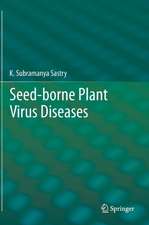Fungal Dimorphism: With Emphasis on Fungi Pathogenic for Humans
Editat de Paul J. Szaniszloen Limba Engleză Paperback – 28 noi 2012
Preț: 721.19 lei
Preț vechi: 759.15 lei
-5% Nou
Puncte Express: 1082
Preț estimativ în valută:
137.100€ • 144.47$ • 114.19£
137.100€ • 144.47$ • 114.19£
Carte tipărită la comandă
Livrare economică 07-21 aprilie
Preluare comenzi: 021 569.72.76
Specificații
ISBN-13: 9781468449846
ISBN-10: 1468449842
Pagini: 416
Ilustrații: XVIII, 396 p. 90 illus.
Dimensiuni: 152 x 229 x 22 mm
Greutate: 0.55 kg
Ediția:Softcover reprint of the original 1st ed. 1985
Editura: Springer Us
Colecția Springer
Locul publicării:New York, NY, United States
ISBN-10: 1468449842
Pagini: 416
Ilustrații: XVIII, 396 p. 90 illus.
Dimensiuni: 152 x 229 x 22 mm
Greutate: 0.55 kg
Ediția:Softcover reprint of the original 1st ed. 1985
Editura: Springer Us
Colecția Springer
Locul publicării:New York, NY, United States
Public țintă
ResearchCuprins
I. Introduction and General Morphology.- 1 An Introduction to Dimorphism among Zoopathogenic Fungi.- 2 Cytological and Ultrastructural Aspects of Dimorphism.- II. Fungi with Yeast Tissue Morphologies.- 3 Blastomyces dermatitidis.- 4 Studies on Phase Transitions in the Dimorphic Pathogen Histoplasma capsulatum.- 5 Paracoccidioides brasiliensis.- 6 Sporothrix schenckii.- III. Fungi with Yeast and Hyphal Tissue Morphologies.- 7 Candida albicans.- 8 Exophiala werneckii.- 9 Polymorphism of Wangiella dermatitidis.- IV. Fungi with Isotropically Enlarged Tissue Morphologies.- 10 Dimorphism in Chrysosporium parvum.- 11 Phialophora verrucosa and Other Chromoblastomycotic Fungi.- 12 Arthroconidium-Spherule-Endospore Transformation in Coccidioides immitis.- V. Dimorphic Mucors.- 13 Mucor racemosus.- 14 Dimorphism in Mucor Species with Emphasis on M. rouxii and M. bacilliformis.





